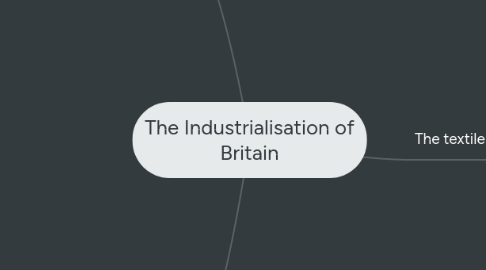
1. The textile industry
1.1. The domestic system
1.1.1. Cloth by hand
1.1.2. Countryside
1.1.3. Women -spinning wheel
1.1.4. Men - loom
1.1.5. Small, hand powered machines
1.1.6. Slow system, not much produce
1.2. The factory system
1.2.1. New machines
1.2.2. Expensive + too big for cottages
1.2.3. Rich factory owners bought them ^
1.2.4. Powered by water so near rivers
1.2.5. Later powered by steam engines
1.2.6. Lots of workers needed
1.2.7. Cities grew around factories
1.2.8. Mass production
1.3. New inventions
1.3.1. Flying shuttle, John Kay
1.3.2. Spinning Jenny, James Hargreaves
1.3.3. Water frame, Richard Arkwright
1.3.4. Spinning mule, Samuel Crompton
1.3.5. Power loom, Edward Cartwright
2. The coal industry
2.1. Reasons for demand increase 1750
2.1.1. Coal heated water, made steam
2.1.2. Powered locomotives and steam ships
2.1.3. Burned to make coke, used to smelt iron
2.2. Coalmines
2.2.1. Most seams of coal deep underground
2.2.2. Mine shafts dug straight down
2.2.3. Tunnels dug at right angles to mine shaft
2.2.4. Wooden supports stopped cave ins
2.2.5. Miners used pickaxes and shovels
2.2.6. Ropes and pulleys brought coal to surface in iron cages
2.3. Dangers
2.3.1. Flooding
2.3.1.1. Watt's steam engine
2.3.2. Explosions
2.3.2.1. Davy safety lamp
2.3.2.2. Trappers
2.3.3. Collapsing roofs
2.3.3.1. Wooden beams
2.3.3.2. Pillars of coal
3. The iron industry
3.1. Smelting
3.1.1. Charcoal used to extract iron from ore
3.1.2. Limestone used to get rid of impurities
3.1.3. Limestone expensive due to lack of
3.2. Wrought iron
3.2.1. Abraham Darby, decided to use coke
3.2.2. Molten pig iron best with a hammer, removes impurities
3.2.3. Cheaper than smelting
3.3. Puddling and rolling
3.3.1. Henry Cort
3.3.2. Better quality wrought iron + cheaper
3.3.3. 15 tonnes wrought iron / hour
3.3.4. Easy to shape, ideal for machines
3.4. Steel
3.4.1. Henry Bessemer
3.4.2. Converter method
3.4.2.1. Vessel filled with liquid pig iron
3.4.2.2. Chemicals added
3.4.2.3. Hot air passed through, gets rid of impurities
3.4.2.4. Allow steel to harden
3.4.3. Advantages
3.4.3.1. Cheaper to make
3.4.3.2. Stronger than wrought iron
3.4.3.3. Less likely to crack, more flexible
